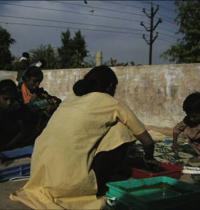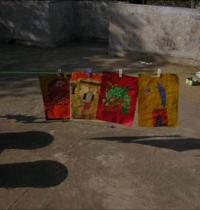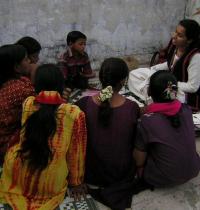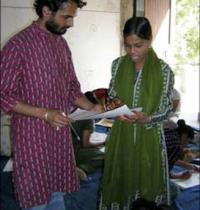Vasudha Thozhur
Grant Period: Over one year and six months
In November 2002, with a seed grant awarded under IFA’s arts collaboration programme, visual artist Vasudha Thozhur and activist-writer/researcher Bina Srinivasan, began work on a four-month project to produce posters that could be characterised as a secular response to the Gujarat riots of February 2002. The team had imagined that the posters would be a result of art workshops with women survivors of the riots, whom Bina had worked with in trauma counselling sessions, in the preceding months. Although the exigencies of ‘the emergency situation’, meant that these workshops were not eventually held, the seed grant enabled Bina and Vasudha to create a series of posters that reinforced constitutional rights — violated with impunity in Gujarat recently—in the wake of the declaration of state elections. While these posters did not have their intended reception—the then Election Commissioner banned the use of posters for electioneering in what was a highly volatile political situation — they were later printed and sold to different NGO groups, distributed during demonstrations and plastered on city walls. The posters also served as an exhibit at ‘Witnessing to Silence: Art and Human Rights’, a series of seminars, art-shows and events organised by the Humanities Research Centre at the Australian National University, Canberra. Ms Thozhur’s experience of working on these posters has also been collated into a document, ‘The Story of Five Posters’.
For Ms Thozhur, the seed grant opened up new possibilities for her work. However, Bina Srinivasan’s rather half-hearted participation meant that Ms Thozhur had neither been able to use Ms Srinivasan’s writings in any substantial way, nor been able to forge sustainable links with NGOs that she was in touch with; and this prevented the seed grant project from being considered for a full-fledged collaboration grant. Ms Thozhur, however, continued with her efforts to identify an organisation that she could partner in order to work with women survivors of the riots. In January 2004, she approached IPA, along with Himmat, a newly formed NGO, that would facilitate this collaboration. Programme staff concluded that while the proposal had merit, and was a valuable intervention in contemporary arts practice, the relationship between the Himmat women and Ms Thozhur could not justifiably be called ‘collaborative’ in character.
Thozhur’s proposal to conduct a series of workshops for women survivors of the Gujarat riots, in association with Himmat, was accepted for consideration under IFA’s ‘special grants’. ln April 2003, l8 riot-affected women from Narodia Patia, Ahmedabad, l2 of whom had lost their husbands in the carnage, came together to explore viable employment options. They named the group ‘Himmat’, began learning to sew and embroider, and to read and write. This process was facilitated by Monica Wahi, a film editor by profession, who came to Ahmedabad in the wake of the riots and stayed on to work with the victims. The women work on weekdays. Sunday evenings, however, are kept aside for different types of workshops, film screenings, music/theatre events, and to create a platform to discuss personal issues, including health and family welfare. In the past year, Himmat has grown into a production unit that tailors a variety of products from organically dyed, block-printed Khadi. Ms Thozhur will work closely with Ms Wahi on this project, especially towards orienting the women to the notion of artistic expression as a creative and therapeutic exercise.
Ms Thozhur will take workshops with live women regularly for l8 months. She will design and conduct l0 two-week sessions during the term of the grant. While the workshops will explore notions of colour, composition, and form, using both conventional media and found materials, Ms Thozhur intends to focus on enabling the women to produce narrative works that record their own stories and help them come to terms with their traumatic past. She will work closely with Himmat’s ‘master tailor’, and on occasion call on external resource persons for technical help and advice. The drawings, sketches, and assemblage that the women create would be used as cartoons that can be traced on to fabric for embroidery or as posters that will speak of issues they feel strongly about. With Ms Wahi, she will also digitalise the women’s works and attempt to use the digital media for further explorations in creativity.




